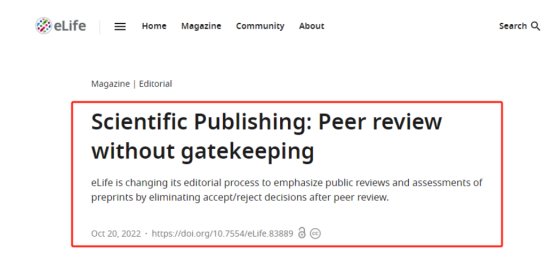Please click the button below to go to our email login page
|
Big News! The publishing cycle of a premier Q1 journal is shortened to 79 days, together with 1/4 reduction in submission volumeDo you remember the news? On Oct. 20, 2022, eLife, an internationally well-known comprehensive journal of biology, announced that from January 31, 2023, eLife will end accept/reject decisions following peer review, and publish the paper online directly.
The news sparks a storm of discussion immediately in the academic field, and even the journal Science rapidly published an article describing this event as “subversive”.
The supporter for this revolution thinks that this system can prevent peer review from being an accumulator of reputation, and avoid those captious journals to become arbiters that decide which work is significant through rejecting heaps of manuscripts. They believe this move to empower authors is long overdue. Others, including several academic editors of eLife (most of which are senior researchers), are less pleased, because they concern that this move will undermine the brand reputation they are trying to build and present discontent over the aggressiveness of the new rule. However, nearly 8 months have passed since the journal decided to initiate the new policy. So has eLife’s new model really acquired widespread recognition? What is the development status of eLife? For these questions, a recent article published on Science News provides the answers!
An analysis report in this article revealed that more than 6 months after the new model of “no rejection” has been initiated by eLife, an internationally well-known comprehensive journal of biology, the impact become apparent with notable shortened publishing period and reduction in submission volume. Under the new publishing model, eLife will instead publish every paper after peer review as a Reviewed Preprint, a new type that combines the manuscript with detailed review comments. Meanwhile, authors have the option to select traditional publication process, but over 90% authors chose the new publication model from February to July in this year. Compared with the same period in 2022, the total submission volume of eLife is 3223, reduced by 25%. The average publishing period of the preprint with review comments is 79 days, far below the average publishing period of 232 days under the old model. 71% of the reviewing editors think the quality of submissions has improved or remained the same, while only 42% of senior editors agree with this view. eLife suggests that the number has basically met the goal, although the submission volume is decreased in this year relative to previous years. |



